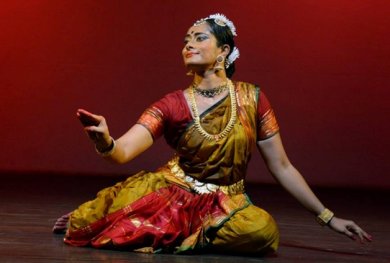
|   |

|   |
Vaidehi: The universal embodiment of power - Satish Suri e-mail: satishism@yahoo.co.in September 26, 2014 Anuradha Venkatraman presented ‘Vaidehi’ that explored several facets of Sita’s personality through a thematic presentation on the 31st August at Seva Sadan under the auspices of Ananya, Bangalore. Conceptualised and choreographed by Anuradha Venkatraman, the narrative draws its inspiration from several sources like Ram Charit Manas, Valmiki, Kambha and Adhbhuta Ramayana exploring several unusual facets of the character and personality of Sita. Sita is shown as a powerful heroine shaping the events around with dignity and honour. In today’s world of women fighting for a rightful place in society, Vaidehi attempts to celebrate the first feminist reference in many of their lives.  A soul stirring and evocative invocation praising Sita as the embodiment of the Trinity, the creator, sustainer and destroyer set the tone and rhythm of the presentation. The delineation proceeded to show Ravana’s penance to obtain immortality and supremacy over the three worlds. Grace and fluidity characterised her nritta and abhinaya interspersed with sancharis depicting the despair of Mandodari, the discovery of the divine baby girl in the field by King Janaka whom he names as Sita, the wedding of Sita to Rama and her subsequent abduction by Ravana. Sita admonishes Ravana for his perversity and refuses to be tempted by wealth or money as she and Rama are as inseparable as sun and sunshine. Anuradha essayed the multiple roles displaying technical competence and histrionic abilities. Her choreographic skills, aesthetics and variegated movements came to the fore dominating the presentation. The finale was like the dawn of the resplendent sun, dynamic and glorious. Ravana is killed and Sita is rescued. However when asked to prove her purity, Sita challenges Rama to kill the thousand headed Ravana of Pushkar. As Rama battles with Pushkara Ravana, he is overwhelmed and swoons in the battle. Sita grasps Rama’s bow and arrow and assumes the terrible form of Maha Kali - four armed with blazing ornaments, matted hair, carrying a bell and a noose. She pounces on Ravana and cuts off his thousand heads. Rama praises her in thousand names and asks Sita to abandon her terrible form. She soon assumes her gracious benign form. The presentation of this piece by the artist was intense and graphic showing commendable skill in the portrayal of Vaidehi, the warrior aspect of Sita. Credit should be given to the excellent musical score which added substance and value to the presentation - music composed by Vidya Srinivasan supported on the vocals by K. Venkateswaran, Vidya Srinivasan and Srividya Ramnath, rhythm and percussion by Lalgudi Sriganesh with D.V. Prasanna Kumar on the rhythm pad, complimented by Dayakar on the violin and Pushpa Kashinath on the veena. The music was on a recorded track and if it were live would have further enhanced and embellished the creative concept and production values of Vaidehi. One had the opportunity to see glimpses of different versions of the old established tale and Anuradha Venkatraman must be congratulated for the effort in bringing together this production. Some fine tuning and editing will definitely help in making it more cohesive. Satish Suri has been an ardent follower of dance and music for more than 40 years, starting with being on the committee of the International Music and Arts Society founded by Vijaya Devi, sister of the Late Maharaja of Mysore, Jayachamarajendra Wodeyar and now presently is treasurer of World Dance Alliance Karnataka Chapter. He has presented several artistes, both dancers and musicians, over the last 40 years. |